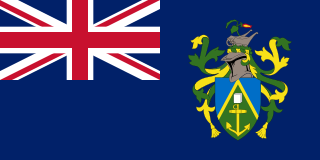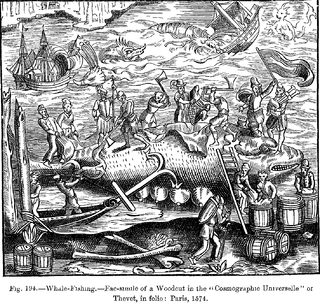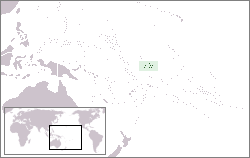Related Research Articles

The Pitcairn Islands, officially the Pitcairn, Henderson, Ducie and Oeno Islands, is a group of four volcanic islands in the southern Pacific Ocean that form the sole British Overseas Territory in the Pacific Ocean. The four islands—Pitcairn, Henderson, Ducie and Oeno—are scattered across several hundred miles of ocean and have a combined land area of about 18 square miles (47 km2). Henderson Island accounts for 86% of the land area, but only Pitcairn Island is inhabited. The islands nearest to the Pitcairn Islands are Mangareva at 688 km to the west and Easter Island at 1,929 km to the east.

Nantucket is an island about 30 miles (48 km) south from Cape Cod. Together with the small islands of Tuckernuck and Muskeget, it constitutes the Town and County of Nantucket, a combined county/town government in the state of Massachusetts.

The history of the Pitcairn Islands begins with the colonization of the islands by Polynesians in the 11th century. Polynesian people established a culture that flourished for four centuries and then vanished. They lived on Pitcairn and Henderson Islands, and on Mangareva Island 540 kilometres (340 mi) to the northwest, for about 400 years.

This article discusses the history of whaling from prehistoric times up to the commencement of the International Whaling Commission (IWC) moratorium on commercial whaling in 1986. Whaling has been an important subsistence and economic activity in multiple regions throughout human history. Commercial whaling dramatically reduced in importance during the 19th century due to the development of alternatives to whale oil for lighting, and the collapse in whale populations. Nevertheless, some nations continue to hunt whales even today.

Essex was an American whaling ship from Nantucket, Massachusetts, which was launched in 1799. On 20 November 1820, while at sea in the southern Pacific Ocean under the command of Captain George Pollard Jr., the ship was attacked and sunk by a sperm whale. Thousands of miles from the coast of South America with little food and water, the 20-man crew was forced to make for land in the ship's surviving whaleboats.

Oeno Island or Holiday Island is an uninhabited coral atoll in the South Pacific Ocean, part of the Pitcairn Islands overseas territory.

Henderson Island is an uninhabited island in the south Pacific Ocean. It is part of the Pitcairn Island Group, together with Pitcairn, Oeno, and Ducie Islands. Measuring 9.6 by 5.1 kilometres, it has an area of 37.3 km2 (14.4 sq mi) and is located 193 km (104 nmi) northeast of Pitcairn Island. It has poor soil and little fresh water, and is unsuitable for agriculture. There are three beaches on the northern end and the remaining coast comprises steep cliffs up to 15 m (50 ft) in height. In 1902, it was annexed to the Pitcairn Islands colony, which is now a British Overseas Territory.

Ducie Island is an uninhabited atoll in the Pitcairn Islands. It lies east of Pitcairn Island, and east of Henderson Island, and has a total area of 1.5 square miles (3.9 km2), which includes the lagoon. It is 1.5 miles (2.4 km) long, measured northeast to southwest, and about 1 mile (1.6 km) wide. The island is composed of four islets: Acadia, Pandora, Westward and Edwards.

Owen Chase was first mate of the whaler Essex, which sank in the Pacific Ocean on November 20, 1820, after being rammed by a sperm whale. Soon after his return to Nantucket, Chase wrote an account of the shipwreck and the attempts of the crew to reach land in small boats. The book, Narrative of the Most Extraordinary and Distressing Shipwreck of the Whale-Ship Essex, was published in 1821 and would inspire Herman Melville to write Moby-Dick.

Vatoa is an outlier of Fiji's Lau Group.

A whaler or whaling ship is a specialized vessel, designed or adapted for whaling: the catching or processing of whales.

Winslow Reef is an underwater feature of the Phoenix Islands, Republic of Kiribati, located 200 kilometres (120 mi) north-northwest of McKean Island at 01°36′S174°57′W. It is the northernmost and westernmost feature of the Phoenix Islands, not counting the outlying Baker and Howland Islands. It has a least depth of 11 m (36 ft). The reef is about 1.6 km (1 mi) long east–west, and about half that wide. The bottom is pink coral and red sand.

The Nantucket was a 350-ton whaler built in Nantucket, Massachusetts in 1837. First master, David N. Edwards, 1837-40, then: George Washington Gardner, 1841–45; Benjamin C. Gardner, 1845–50; Richard C. Gibbs 1850-54 ; Richard C. Gibbs (1855–59).

The Coffin family was prominent in the history of whaling in the United States, operating ships out of Nantucket, Massachusetts, from the 17th to 19th centuries. Some members of the family gained wider exposure due to their discovery of various islands in the Pacific Ocean.

Commercial whaling in the United States dates to the 17th century in New England. The industry peaked in 1846–1852, and New Bedford, Massachusetts, sent out its last whaler, the John R. Mantra, in 1927. The Whaling industry was engaged with the production of three different raw materials: whale oil, spermaceti oil, and whalebone. Whale oil was the result of "trying-out" whale blubber by heating in water. It was a primary lubricant for machinery, whose expansion through the Industrial Revolution depended upon before the development of petroleum-based lubricants in the second half of the 19th century. Once the prized blubber and spermaceti had been extracted from the whale, the remaining majority of the carcass was discarded.
The whaler Globe, of Nantucket, Massachusetts, was launched in 1815. She made three whaling voyages and then in 1824, on her fourth, her crew mutinied, killing their officers. Eventually most of the mutineers were killed or captured and the vessel herself was back in Nantucket in her owners' hands. She continued to whale until about 1828. She was broken up circa 1830.
George Pollard Jr. (1791–1870) was the captain of the whalers Essex and Two Brothers, both of which sank. Pollard's life, including his encounter with the sperm whale that sank Essex, served as inspiration for Captain Ahab, the whale-obsessed character in Herman Melville's Moby-Dick.
Several ships have been named Cyrus for Cyrus:
Rambler was launched in America in 1812. The British captured her in 1813 as she was returning to America from Manila. She then briefly became a West Indiaman. In 1815 she became a whaler in the Southern Fishery. She made four complete whaling voyages and was wrecked on her fifth.
Renown was launched in 1794 at New Bedford, Massachusetts. She made four voyages from Nantucket as a whaler. In 1813, while she was on her fifth American whaling voyage, she became the first American whaler that British whalers captured in the South Seas. She was sold in London and under the name Adam became first a London-based transport and then a British Southern Whale Fishery whaler. She made four whaling voyages and was wrecked in 1825 at the outset of her fifth British whaling voyage.
References
- ↑ "Oeno Island". Pitcairn Islands Study Center. Pacific Union College . Retrieved 9 July 2020.
- ↑ Estabrooks, Caleb (January 28, 2020). "The Whale Ship Oeno". nsrwa.org. Retrieved July 17, 2023.
- 1 2 3 The Whale Ship OENO. The North and South Rivers Watershed Association. 28 January 2020. Retrieved 2021-02-03.
- ↑ Dulles, Foster (1930). The Old China Trade. Cambridge, Massachusetts: Riverside Press. p. 100 – via University of Chicago.
- ↑ Philbrick, Nathaniel (2001). Sea of Glory: America's Voyage of Discovery, the U.S. Exploring Expedition, 1838-1842. Penguin Books.